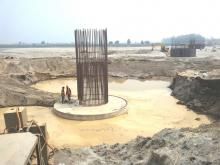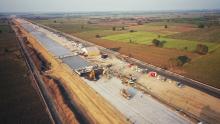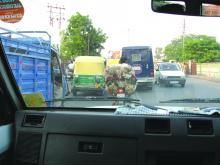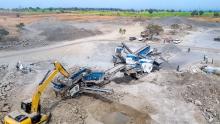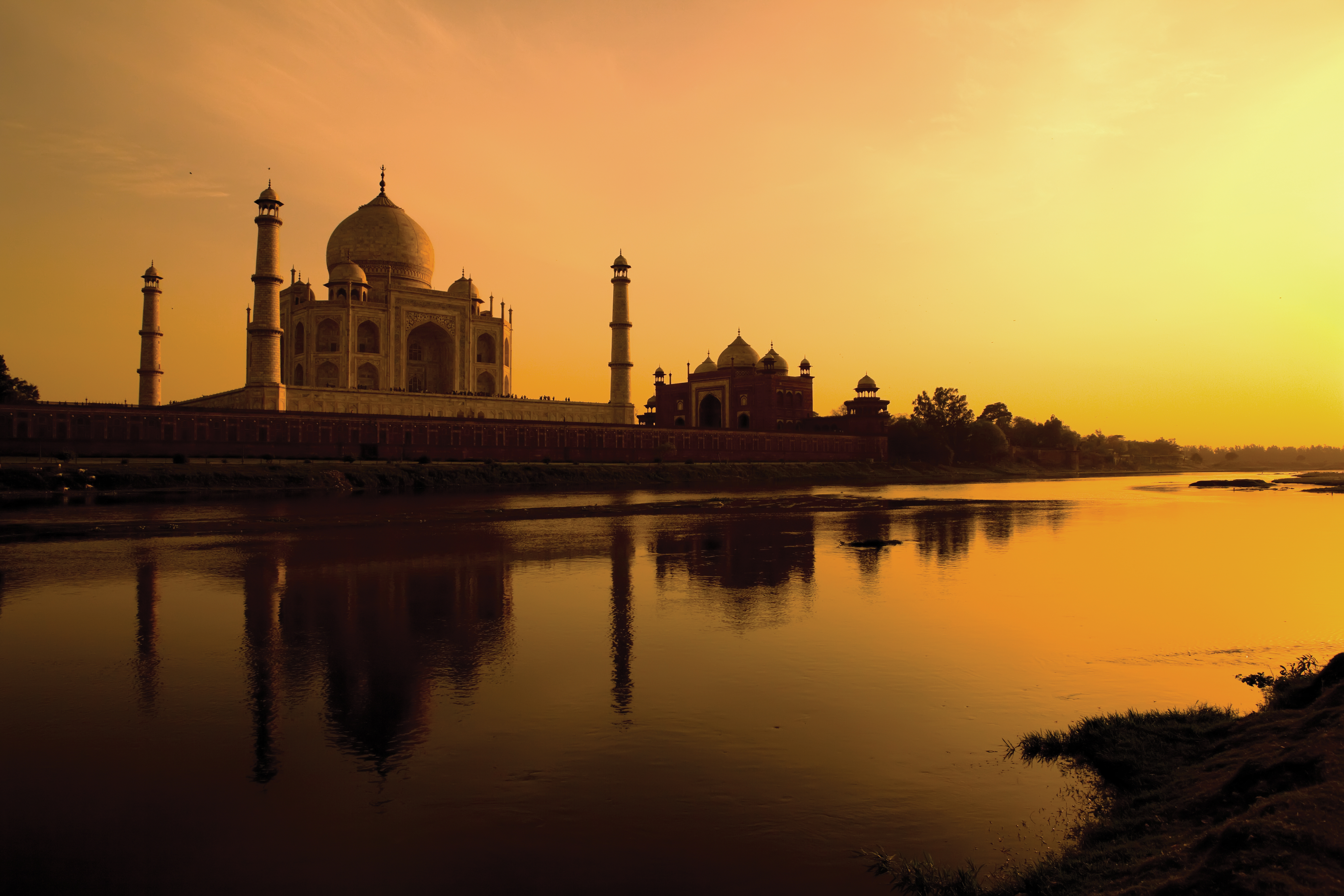
Earlier this year, a new expressway was opened to traffic in India, adding connectivity to the country’s road network - Mike Woof reports
India’s economic growth has fuelled a massive construction boom in the country. Road building has been set as a priority by the Indian Government to help ensure continued economic development and improve connectivity between major population centres. One major new expressway has recently opened to traffic, having been designed to international standards and provides insight into how other key routes in the country will be developed. The importance of this new expressway both for economy and as a symbol of the country’s development cannot be overstated, as it links India’s capital with the country’s single most important tourist attraction, the world-famous Taj Mahal.Industry is hugely important to India but tourism remains an important component of the country’s income. With tourists flocking through capital Delhi to historic Agra, the new expressway is now one of the most widely used routes by foreign visitors to India.
The expressway is one of the latest and largest in a series of major road projects to be completed in the country. Tolled highways now connect many of the largest cities, with major routes linking Delhi, Mumbai, Chennai and Kolkata, the Golden Quadrilateral. More projects are in hand to continue the expansion programme, although this has not been without its problems as land expropriation has led to disagreements, disputes and in some cases, even rioting. In the main however, road construction is regarded favourably by most in that it can be seen to help boost economic development and reduce poverty.
The geographical scale of India has meant funding the necessary highway construction is impossible solely by the state. Instead the concession and PPP models are being used widely in India with private investment being encouraged to widen the network. India’s size means that the scale of the road building programme is immense with the Indian Government planning US$17 billion of financing over the next five years for the necessary projects. This is being sourced through public-private partnership road projects, with the programme starting in the 2012/2013 financial year. This finance stream will be used by the
Part of the the Ministry of Highways and Road Transport, the NHAI is at present responsible for the management of 72,000km of highways in India. The highway development programme initially commenced in 2000 and has been carried out in various phases, with a series of projects currently in hand. And the Indian Government fully intends to keep the momentum going having stated that it will put 7,300km of road projects out to tender every year, for the next three years.
The centre of India is home to much of its industry and road development has been set as one of the priorities for the country. A major road project was opened for traffic in India this year, representing a significant boost to the country’s network. Connecting capital Delhi with the historical and industrial city of Agra, the new Yamuna Expressway will make a massive impact for both tourism and industry. This has been a substantial project and the estimated cost for the construction of the Yamuna Expressway was around US$2 billion, including the cost of interchanges, utility services, environmental mitigation measures and land resettlement and rehabilitation.
In all, construction of the Yamuna Expressway called for the acquisition of 4,406ha of land, which represented a substantial portion of the cost of the work overall.
The route runs from Noida, just to the south of Delhi, and also runs through the holy city of Mathura before ending at Agra. Home to the Taj Mahal (as well Agra Fort, Fatehpr Sikr and several other important cultural sites), Agra is India’s biggest tourist destination. The city and the surrounding area is also home to many industries and plays an important role in the country’s economy. Between Delhi and Agra lies a very commercially active area of India and this new expressway will help develop the economy further through increasing road capacity, while vastly reducing journey times. Of note is the fact that this is presently the longest operational expressway in India and this new 166km link is opening up the region for industrial and urban development, as well as boosting tourism and other allied industries.
The Yamuna Expressway runs from the Noida-Greater Noida expressway near Pari Chowk in Greater Noida to km 210 of the National Highway 2, situated near to Agra. The road passes through the districts of Gautam Buddha Nagar, Aligarh, Mathura, Hathras and Agra in the State of Uttar Pradesh. The route takes the road through a corridor lying between left bank of the river Yamuna on one side and the Old Grand Trunk Road (NH-91) on the other side, between Noida and Agra.
The construction of the highway was identified as a priority for the region, as well as for India as a whole. The authorities recognised the need to provide a fast moving corridor to minimise the travel time and connect the main townships and commercial centres on the eastern side of Yamuna. The new link would also increase safety. But to ensure development of the adjoining areas, it was necessary to reduce traffic volumes on the NH-2, which is already congested and runs through the centre of cities including Faridabad, Ballabgarh and Palwal.
The new Yamuna Expressway provides connectivity with the existing NH-2 as well as the NH-91 highway. Together the three main routes now deliver an improved network that will boost accessibility and help in opening up vast areas in Noida and Greater Noida, as well as Aligarh, Mathura and Agra, for development. Providing safer transport and shorter travel times as well as improved accessibility is expected to accelerate development along the route of the Yamuna Expressway for commercial, industrial and residential use.
As with many other major road projects in India, this expressway has been built on the design, finance, build, operate and transfer (DFBOT) model. To administrate the project the Yamuna Expressway Industrial Development Authority (YEIDA) was established by the Government of Uttar Pradesh and given responsibility for managing the work. This responsibility covered implementation, monitoring, deciding policy and the various technical parameters. It also included urban and industrial development patterns in the immediate area of the proposed route.
The concession agreement for the expressway was signed between YEIDA and Jaiprakash Industries in early February 2003. Following this, Jaiprakash Industries was renamed Jaypee Infratech and this company took on the role of concessionaire for the Yamuna Expressway, with a 36 year concession to collect tolls from drivers using the link. The agreement also gave Jaypee Infratech the rights to develop around 25 million m2 of land for commercial, industrial and residential use along the route of the Yamuna Expressway. This in itself was a hugely important commercial deal and one of the largest parcels of land is in Noida/Greater Noida and covers some 5 million m2, offered on a 90 year lease at an agreed rate.
Construction work for the Yamuna Expressway commenced in August 2008 and the road was formally opened to traffic just four years later, on 9th August 2012.
Although the Yamuna Expressway runs parallel to existing road routes, there was considerable need for the construction of this new link. The Delhi – Mathura – Agra NH-2 and Ghaziabad – Aligarh – Kanpur NH-91 National Highways follow broadly similar routes to the Yamuna Expressway and also help provide inter-connectivity at different locations. However both of these National Highways had severe congestion issues due to enormous traffic volumes. As these roads also pass through busy urban areas, this further increased travel times for users. However the new expressway is carrying much of the inter-city traffic from these two corridors and is making major reductions in travel times between Noida and Agra. And drivers using the Yamuna Expressway currently take just half the time for the Noida-Agra journey than if they drive long the NH-2 or NH-91 National Highways.
As there is considerable real estate and industrial development either taking place or planned along the route of the expressway, the planners expect further traffic growth in the near future. The expressway is expected to carry 30,000-35,000 vehicles/day along the majority of its length during the first 12 months following its opening. And this is expected to increase to some 60,000 vehicles/day by 2021. This projected traffic growth meant that the expressway alignment also allows for future widening work. The expressway at present features three lanes running in either direction, although it can be widened later to four lanes in either direction.
The team working on the project adopted design standards for the expressway after studying the best international standards. However, the design standards of operational expressways in India such as the Mumbai-Pune and Ahmedabad-Vadodara routes also played an influential role in those set for the Yamuna project. JP Infratech employed the services of Intercontinental Consultants and Technocrats (ICT), and Consulting Engineering Services (India) for the design of the expressway. There were four project management consultants: LEA Associates South Asia; Intercontinental Consultants and Technocrats; Scott Wilson India; Consulting Engineering Services India.
The Yamuna Expressway has a design speed of 120km/h, with a posted speed limit of 100km/h for light vehicles and 60km/h for heavy vehicles. To allow these speeds the minimum curve radii on the expressway is 760m while the maximum gradient is 2.5%.
As the expressway runs in the flood plain of the Yamuna River along a considerable portion of its length, this has been a major guiding factor in the design of the road. The expressway lies on top of an embankment for much of its length to protect it from potential flooding, while the road has also been designed carefully to minimise the risk of subsidence. In addition, the road has been constructed with surface chute drains on either side so that run-off from the carriageways will not erode the embankment slopes, a design that takes note of India’s high seasonal rainfall.
To carry out the 165km project the work was divided into three main categories. Package A was for the construction of embankments, culverts and cart track underpasses, while Package B was for the construction of interchanges, bridges and vehicular underpasses and Package C was for the construction of rigid pavements and granular layers. Each of these was split again with Package A divided into 15 lots of some 11km each, Package B into six lots of around 28km each and Package C into three lots of 55km each.
Because of its length, the Yamuna Expressway project required significant earthmoving works for its construction. In all, 38.4 million m3 of earth had to be moved for the expressway project, requiring the use of over 115 excavators and 75 graders, as well as 110 compactors and 725 tipper trucks. To improve work efficiency for the earthmoving work and other construction activity, temporary haul roads were constructed alongside the alignment of the expressway.
To produce the 13 million tonnes of aggregate used in the expressway, four large jaw crushers, six large cone crushers and six 300tonne/hour crushing and screening plants were employed overall. Some of the stone required also had to be transported up to 255km from Bhiwani and Gwalior to where it was needed.
For most of its length the expressway features a concrete construction, with a 320mm Pavement Quality Concrete (PQC) surface and four
Along with the concrete used for the pavement, the project consumed large quantities of cement and other materials: 2.7 million m3 of fly ash; 2.8 million m3 of quality control concrete; 1.2 million tonnes of cement; 0.9 million m3 of concrete in structures; 130,000 tonnes of steel. The concrete produced using 12 x 240m3/hour concrete batching plants, while the contractors also had 12 cement bag splitting systems and 24 cement silos for storage.
Other machines used on the project included 24 mobile lighting towers, 175 water tankers, and more than 100 generator sets. And the work also required the use of various items of equipment including
There were a number of major challenges faced during the construction of the Yamuna Expressway and the designers and various contractors also learned several key lessons from the work that will be of benefit for future expressway projects in India. As the work progressed some changes were required to the structural design of various interchanges, while local groups also called for variations in the placement of underpasses for access and the project also required moving 217 power lines and 66 irrigation channels.
For India’s drivers, the new route marks a notable change from the existing National Highways connecting Delhi with Agra.
Because the expressway was designed for high speed traffic, safety for road users was a prime concern during its design. A 6m wide median divides the expressway, with approved steel crash barriers installed along its full length and on both sides of the carriageway, while there are emergency cross-overs every 5km as well as gantries to provide drivers with traffic information. In addition, a key benefit for Indian use has been the installation of fencing along the route to prevent stray cattle or other animals from wandering into the roadway.
There are six major interchanges and three main toll plazas along the route, as well as a further eight toll plazas on ramps connecting with the expressway. The project also included the construction of 14km of 7m wide services roads as well as 42km of 5.5m wide service roads.
The alignment chosen required the construction of various bridges and overpasses, so as to pass rivers and other roads and on average, there is an underpass every 1km or so. In all there are 41 minor bridges, 70 vehicular underpasses and 76 smaller underpasses for pedestrians or animals, while there are also 183 culverts. Of note too is the fact that the underpasses have been provided with solar powered lighting for safety.
For tourists holidaying in India the journey by road from Delhi to Agra may now reveal
less of the country than when coaches were forced to use the National Highways. But this new expressway will make visiting the world-famous Taj Mahal quicker as well as considerably safer.
KEY FACTS
The estimated cost for the construction of the 166km Yamuna Expressway was around US$2 billion
The expressway is expected to carry 30,000-35,000 vehicles/day following its opening and this will increase to 60,000 vehicles/day by 2021
The Yamuna Expressway has a design speed of 120km/h, with a posted speed limit of 100km/h for light vehicles and 60km/h for heavy vehicles
The project consumed large quantities of cement and other materials: 2.7 million m3 of fly ash; 2.8 million m3 of quality control concrete; 1.2 million tonnes of cement; 0.9 million m3 of concrete in structures; 130,000 tonnes of steel
In all, 38.4 million m3 of earth had to be moved for the expressway project, requiring the use of over 115 excavators and 75 graders, as well as 110 compactors and 725 tipper trucks
To produce the 13 million tonnes of aggregate used in the expressway, four large jaw crushers, six large cone crushers and six 300tonne/hour crushing and screening plants were employed
The project required moving 217 power lines and 66 irrigation channels
The Yamuna Expressway features 41 minor bridges, 70 vehicular underpasses and 76 smaller underpasses for pedestrians or animals

